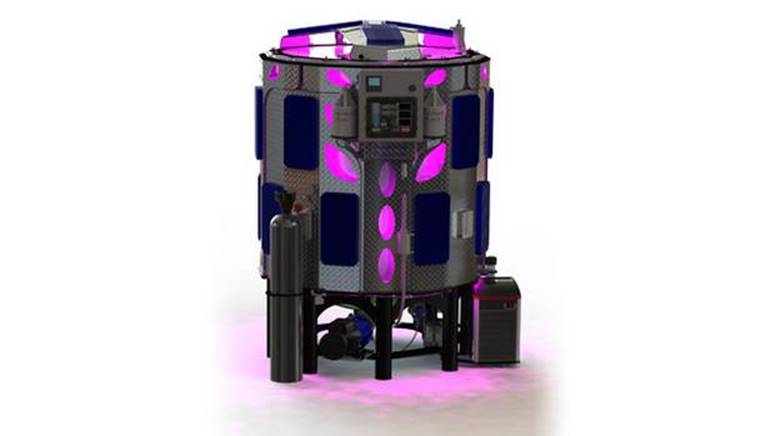October 31 2016
FEEDING THE SEAFOOD FARM INDUSTRY
Interview with Ashley & Robert Roulston
You might think of algae as that slimy stuff in the lake or your aquarium, but to Ashley and Robert Roulston it’s plankton – Industrial Plankton to be exact.
Mr. Roulston is CEO and Ms. Roulston is director of sales and marketing for Industrial Plankton Inc. headquartered in Victoria. The brother and sister moved there from New Brunswick in 2005
They founded their company in 2010, and within three years they unveiled their first bioreactor – an automated system for growing algae that can be used in aquariums, for research, aquaculture and biotech.
”The units are about 1,500 watts of LED [lights] glowing pink, because the lights are a mixture of blue and red, which is what the plant cells like and drives photosynthesis [to create plankton], ” says Mr. Roulston, 35.
It’s about five feet across and 7 feet high (1.5 by 2.1 metres), with 16 sides, a shiny, diamond-shaped object that glows almost ethereally.
”It’s pretty cool, ” he says.
”People say it looks similar to a spaceship, ” says Ms. Roultson, 29. Actually, it resembles a science fiction teleporter, or one of those high-tech body scanners now deployed at airports.
The Roulstons stress that they don’t actually make algae, or plankton. ”We make the equipment to make it, ” Mr. Roulston says. It automates the growing of nutrients needed for seafood farms in a way that’s analogous to the way milking machines changed dairy farms.
Each unit costs around $50,000 and sales are doing well.
”Plankton is used primarily in biotech and aquaculture. Aquaculture operations need to produce [plankton] on site because it’s at the base of the food chain, so you want to grow the ones that are nutritious, ” Mr. Roulston explains.
Algae are used for research too: a professor in North Carolina has purchased a unit to produce algae that will make a protein to treat cystic fibrosis.
Industrial Plankton’s equipment offers growers the precision needed to grow ”good” algae that can be used as feed, unlike the hard-to-control algal blooms such as those in the Great Lakes that contribute to eutrophication.
The aquaculture growers that the Roulstons provide equipment for are primarily shellfish growers, less controversial than the salmon farmers that some environmentalists criticize.
Unlike farmed salmon, which can escape their pens, ”shellfish just sit there, filtering the water, with zero impact on the environment,” Mr. Roulston says.
Machine-grown algae can benefit the environment too, he adds.
”We have a meeting with the biggest aquarium feeder in the world. If they can make algae [and grow species at their aquariums] it can take the pressure off reefs, ” he explains. Right now, aquariums sometimes have to catch fish from reefs for their displays.
The brother and sister are aware that people consider algae to be, well, icky but they hope people think differently.
”When people think of algae they often think of slime, but really the algae our equipment produces is simply single-celled plants, ” Mr. Roulston says.
The Roulstons started their company by raising $1.5 million in seed money. With Robert’s background in biology and engineering and both his and Ashley’s education in business and commerce, they combined their skills, originally looking for ways to make aquaculture more sustainable.
They discovered that growing ”good” algae can be tricky. If it’s grown in open air it can become contaminated, ridden with bacteria and even poisonous to the shellfish and fish that feed on it.
There were lots technical challenges as they constantly improve and calibrate their reactors.
”Pretty much every day, ” Mr. Roulston says.
”The science is complicated because there are so many variables and the technology is really hard to lock down. We had to develop a system that can actually clean itself, eliminating nooks and crannies developing our cleaning systems and heat exchangers.”
”I think being based in Canada was a benefit,” Ashley Roulston says.
”We able to benefit from government programs, research grants.”
In addition to exporting to the United States, Industrial Plankton has already exported units to Europe and Australia.
”We’re looking at Southeast Asia and Japan as well next year,” Ms. Roulston says.
One advantage their company has is that there is little direct competition in the field of manufacturing algae growing bioreactors.
”There’s nobody that has a system like this in the world. It’s far more advanced than anything available. There are several companies making bioreactors but they’re all pretty rudimentary, just bags in open ponds,” Mr. Roulston says.
They’re now developing a new product, a zooplankton reactor that will automate the production of more sophisticated organisms.
”Algae are at the base of the food chain and zooplankton is the next step up. Fish hatcheries depend on them. We’re working on a suite of products that will work up the food chain. It will be out in about six months,” Mr. Roulston says.
Idea Creation: Do you have an innovative product or service? Are you addressing a niche market need? Whatever your idea, draft a thorough business plan that has assessed the product or service need, addresses the competitive environment and articulates how you will viably bring your concept to the marketplace.
Vision: Set clear, measurable short and long-term goals based on your company’s vision and ensure your business has the structure and resources in place to support your end goal. Monitor and track your progress against those goals on a regular basis and adjust as required.
Have a Secure Financial Footing: Whether starting, growing or running a business, having access to capital and cash flow is key. Your financial partner can offer you a wide range of convenient and flexible options to help manage your business through change, including business loans, managing payables and receivables or investing excess cash.
For more Small Business tips from CIBC, visit cibc.com/businessadvice

